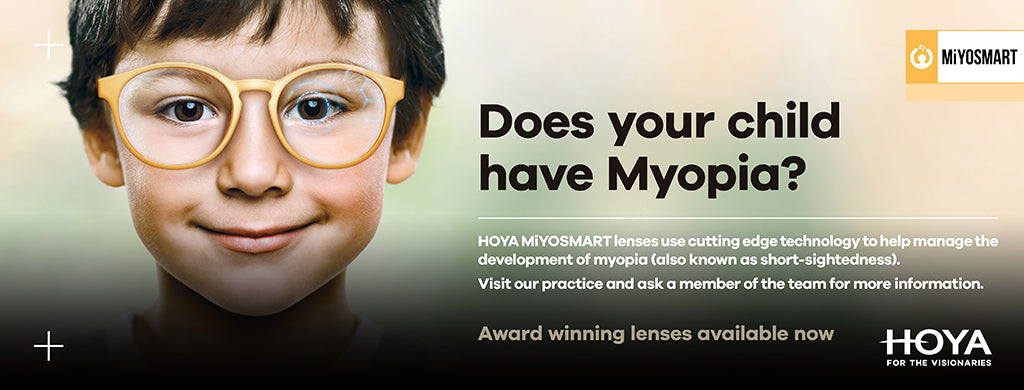The Spectator
Myopia Management
6 Apr 2021
Eye Health
Will my children need specs and be short sighted (myopic) like me?
The majority of parents that ask this question are usually spectacle wearers themselves and the answer to this question is probably yes. The reasons behind this concern are mainly aesthetic, however our concerns as an optometrist isn't aesthetic, (although we will always make sure they look good in their specs) but the lifetime risks that are associated with being short-sighted. Researchers have now started describing myopia as an epidemic. It is an epidemic that can cause sight loss in the long term, not in the form of needing spectacles, but eye diseases that are associated and caused by being short sighted, basically having an eyeball that has become too big. At present research shows that about 28% of the world's population is short-sighted, if the rate of progression continues at the same rate over 50% of the world's population will be short-sighted within the next 30 years.
For years we have, as optometrists, offered advice on how to reduce the rate of progression of myopia. Lifestyle advice such as: as much outdoor time as possible, good indoor lighting in areas where homework is done and reduce screen time where possible. This advice helps, but it only makes a small difference. Over the years there have been many optical appliances that have been thought to help reduce the progression of myopia. The most successful until now has been Ortho-K contact lenses. These contact lenses are a rigid gas permeable lens (a hard lens) that we have been fitting to children and adults for many years. These lenses reshape the cornea at night and the cornea then holds this shape for most of the following day, temporarily correcting the wearers vision without the need of spectacle or contact lenses during the day. These lenses were not originally fitted as a myopia management solution, it just so happened that they also seemed to have a fairly large impact on reducing the rate at which myopia progressed in the young patients that wore them. This is still the most successful way of slowing down the progress of myopia. The negatives to these lenses are that they had to be worn every night and if you did not want to wear them for a few nights you were a bit in limbo with regards to your vision as your uncorrected vision can take up to 2 weeks to stabilise afterwards!
In 2018 a new contact lens came out that was licenced for children to wear during the day and was as effective at reducing myopia progression as Ortho-K. It is a type of multi-focal soft contact lens for children that are at risk of progressive myopia. The initial theory behind a multi-focal lens for children was that this lens worked by reducing the amount the eye had to focus for reading (accommodate), which is one of the old theories of the causes of myopia progression, however it actually works by creating a myopic defocus lens on the peripheral retina. To keep it simple; the theory is that keeping the peripheral retina in a state of short-sighted blur and keeping the centre in sharp focus can trick the body to think the eyeball is already too big and reduces the stimulation to grow further, thus slowing down its growth and reducing the speed at which myopia increases. It's that simple! Because these are soft lenses, they are very easy to adapt to and provide comparable vision and comfort to traditional daily soft lenses. It’s therefore giving you the dual effect of not only correcting your sight, but also aiming to limit progression of the prescription! Win win!
Last month a new form spectacle lens was released, after research over the last few years this can be worn by any age group that has progressing myopia. It works in a similar way to the soft contact lens mentioned above, but rather than having a periphery that has a ring of positive power, it has a ring of very small plus lenses 1mm apart, they are almost invisible to the eye, but creates a peripheral retinal defocus similar to the soft contact lenses.
The research so far has shown that the MiYOSMART lenses could reduce the final myopic prescription on average by up to 60% and therefore limiting risk of future myopia associated eye issues. These lenses are suitable for all children to wear, even if at this point in time they don't need spectacles, but their genetic predisposition predicts they will be and for those that are already short-sighted. If one parent is short-sighted your child has a 1 in 3 chance of being the same or worse and if both parents are it's 1 in 2. At the age of 6 years old we can predict fairly accurately your child's visual future, but we now have the best opportunity to change this predicted future. We have a solution that would enable us to prescribe a visual correction to be worn all day whether it be in the form of contact lenses or spectacles to help provide better long term outcomes, while giving children great vision and flexibility across all day to day activities!
In our opinion a combination of both will be the best solution. Contacts during the day and Spectacles during the evening and on the rest days from contact lenses. Personally, as an Optometrist who is fairly short-sighted, but also a father, I have never been so excited about a lens product that had the possibility of preventing my children becoming as short sighted as me, but more importantly reducing the risks of the eye problems associated with it.
